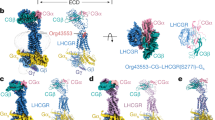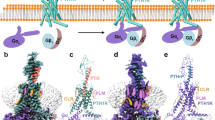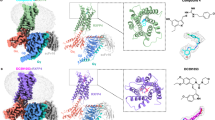Abstract
The structure of the ternary complex between ovine placental lactogen (oPL) and the extracellular domain (ECD) of the rat prolactin receptor (rPRLR) reveals that two rPRLR ECDs bind to opposite sides of oPL with pseudo two-fold symmetry. The two oPL receptor binding sites differ significantly in their topography and electrostatic character. These binding interfaces also involve different hydrogen bonding and hydrophobic packing patterns compared to the structurally related human growth hormone (hGH)–receptor complexes. Additionally, the receptor–receptor interactions are different from those of the hGH–receptor complex. The conformational adaptability of prolactin and growth hormone receptors is evidenced by the changes in local conformations of the receptor binding loops and more global changes induced by shifts in the angular relationships between the N- and C-terminal domains, which allow the receptor to bind to the two topographically distinct sites of oPL.
This is a preview of subscription content, access via your institution
Access options
Subscribe to this journal
Receive 12 print issues and online access
$189.00 per year
only $15.75 per issue
Buy this article
- Purchase on Springer Link
- Instant access to full article PDF
Prices may be subject to local taxes which are calculated during checkout








Similar content being viewed by others
References
DeVlaming, V. Actions of prolactin among the vertebrates. In Hormones and evolution (ed., Barrington, E.J.W.), 561–642 (Academic Press, New York; 1979).
Sinha, Y.N. Structural variants of prolactin: occurrence and physiological significance. Endocrine Rev. 16, 354–369 (1995).
Goffin, V., Shiverick, K.T., Kelly, P.A. & Martial, J.A. Sequence-function relationships within the expanding family of prolactin, growth hormone, placental lactogen, and related proteins in mammals. Endocrine Rev. 17, 385–410 (1996).
Nicoll, C.S., Mayer, G.L. & Russel, S.M. Structural features of prolactins and growth hormones that can be related to their biological properties. Endocrine Rev. 7, 169–203 (1986).
Gertler, A., Grosclaude, J., Strasburger, C.J., Nir, S. & Djiane, J. Real-time kinetic measurements of the interactions between lactogenic hormones and prolactin-receptor extracellular domains from several species support the model of hormone-induced transient receptor dimerization. J. Biol. Chem. 271, 24482–24491 (1996).
De Vos, A.M., Ultsch, M. & Kossiakoff, A.A. Human growth hormone and extracellular domain of its receptor: crystal structure of the complex. Science 255, 306–312 (1992).
Kelly, P.A., et al. The growth hormone/prolactin receptor gene family. Oxford Surveys On Eukaryotic Genes 7, 29–50 (1991).
Schindler, C. & Darnell, J.E.J. Transcriptional responses to polypeptide ligands: the JAK-STAT pathway. Annu. Rev. Biochem. 64, 621–651 (1995).
Ihle, J.N., et al. Signaling by the cytokine receptor superfamily: JAKs and STATs. Trends Biochem. Sci. 19, 222–227 (1994).
Bazan, J.F. Structural design and molecular evolution of a cytokine receptor superfamily. Proc. Natl. Acad. Sci. USA 87, 6934–6938 (1990).
Cosman, D., et al. A new cytokine receptor superfamily. Trends Biochem. Sci. 15, 265–270 (1990).
Fuh, G., et al. Rational design of potent antagonists to the human growth hormone receptor. Science 256, 1677–1680 (1992).
Sandowski, Y., et al. Preparation and characterization of recombinant prolactin receptor extracellular domain from rat. Mol. Cell. Endocrinol. 115, 1–11 (1995).
Tchelet, A. Extracellular domain of prolactin receptor from bovine mammary gland: expression in Escherichia coli, purification and characterization of its interaction with lactogenic hormones. J. Endocrinol. 144, 393–403 (1995).
Sakal, E., et al. Large-scale preparation and characterization of recombinant ovine placental lactogen. J. Endocrinol. 152, 317–327 (1997).
Sakal, E., et al. Cloning, preparation, and characterization of biologically active recombinant caprine placental lactogen. J. Endocrinol. 159, 509–518 (1998).
Sakal, E., Elberg, G. & Gertler, A. Direct evidence that lactogenic hormones induce homodimerization of membrane-anchored prolactin receptor in intact Nb2-11C rat lymphoma cells. FEBS Lett. 410, 289–292 (1997).
Colosi, P., et al. Cloning and expression of ovine placental lactogen. Mol. Endocrinol. 3, 1462–1469 (1989).
Syed, R.S. et al. Efficiency of signalling through cytokine receptors depends critically on receptor orientation. Nature 395, 511–516 (1998).
Livnah, O. et al. Functional mimicry of a protein hormone by a peptide agonist: the EPO receptor complex at 2.8 Å. Science 273, 464–471 (1996).
Kossiakoff, A.A. & De Vos, A.M. Structural basis for cytokine hormone-receptor recognition and receptor activation. Adv. Protein Chem. 52, 67–108 (1998).
Abdel-Meguid, S.S. et al. Three-dimensional structure of a genetically engineered variant of porcine growth hormone. Proc. Natl. Acad. Sci. USA 84, 6434–6437 (1987).
Rhee, H.K. et al. Biological activity and immunological reactivity of human prolactin mutants. Endocrinology 136, 4990–49995 (1995).
Gertler, A., et al. Preparation, purification, and determination of the biological activities of 12 N terminus-truncated recombinant analogues of bovine placental lactogen. J. Biol. Chem. 267, 12655–12659 (1992).
Rosakis-Adcock, M. & Kelley, P.A. Identification of ligand binding determinants of the prolactin receptor. J. Biol. Chem. 267, 7428–7433 (1992).
Somers, W., Ultsch, M., De Vos, A.M. & Kossiakoff, A.A. The X-ray structure of the growth hormone-prolactin receptor complex. Nature 372, 478–481 (1994).
Kossiakoff, A.A. et al. Comparison of the intermediate complexes of human growth hormone bound to the human growth hormone and prolactin receptors. Protein Sci. 3, 1697–1705 (1994).
Wilson, I.A. & Jolliffe, L.K. The structure, organization, activation and plasticity of the erythropoietin receptor. Curr. Opin. Struct. Biol. 9, 696–704 (1999).
Cunningham, B.C. & Wells, J.A. Rational design of receptor-specific variants of human growth hormone. Proc. Natl. Acad. Sci. USA 88, 3407–3411 (1991).
Cunningham, B.C., Bass, S., Fuh, G. & Wells, J.A. Zinc mediation of the binding of human growth hormone to the human prolactin receptor. Science 250, 1709–1712 (1990).
Clackson, T. & Wells, J.A. A hot spot of binding energy in a hormone-receptor interface. Science 267, 383–386 (1995).
Remy, I., Wilson, I.A. & Michnick, S.W. Erythropoietin receptor activation by ligand-induced conformation change science. Science 283, 990–993 (1999).
Livnah, O., et al. An antagonist peptide-EPO receptor complex suggests that receptor dimerization is not sufficient for activation. Nature Struct. Biol. 5, 993–1004 (1998).
Livnah, O. et al. Crystallographic evidence for preformed dimers of erythropoietin receptor before ligand activation. Science 283, 987–990 (1999).
Herman, A., Helman, D., Livnah, O. & Gertler, A. Ruminant placental lactogens act as antagonists to homologous growth hormone receptors and as agonists to human or rabbit growth hormone receptors. J. Biol. Chem. 274, 7631–7639 (1999).
Lebrun, J.J., Ali, S., Sofer, L., Ullrich, A. & Kelly, P.A. Prolactin-induced proliferation of Nb2 cells involves typrosine phosphorylation of the prolactin receptor and its associated tyrosine kinase JAK2. J. Biol. Chem. 269, 14021–140266 (1994).
Argetsinger, L. et al. Identification of JAK2 as a growth hormone receptor-associated tyrosine kinase. Cell 74, 237–244 (1993).
Pearce, K.H., Cunningham, B.C., Fuh, G., Teeri, T. & Wells, J.A. Growth hormone binding affinity for its receptor surpasses the requirements for cellular activity. Biochemistry 38, 81–89 (1999).
Christinger, H.W. et al. Crystallization of ovine placental lactogen in a 1:2 complex with the extracellular domain of the rat prolactin receptor. Acta Crystallogr. D 54, 1408–1411 (1998).
Collaborative Computational Project, Number 4. CCP4 Suite: programs for protein crystallography. Acta Crystallogr. D 50, 760–763 (1994).
Brünger, A.T. X-PLOR reference manual 3.0 edn (Molecular Simulations, Inc., Waltham, Massachusetts; 1992).
Huang, M. et al. The mechanism of an inhibitory antibody on TF-initiated blood coagulation revealed by the crystal structures of human tissue factor, Fab 5G9 and TF.G9 complex. J. Mol. Biol. 275, 873–894 (1998).
Zhang, X.J. & Matthews, B.W. Enhancement of the method of molecular replacement by incorporation of known structural information. Acta Crystallogr. D 50, 675–686 (1994).
Inaka, K., Taniyama, Y., Kikuchi, M., Morikawa, K. & Matsushima, M. The crystal structure of a mutant human lysozyme C77/95A with increased secretion efficiency in yeast. J. Biol. Chem. 266, 12599–12603 (1991).
Brünger, A.T. Free R value: a novel statistical quantity for assessing the accuracy of crystal structures. Nature 355, 472–475 (1992).
Read, R. Improved Fourier coefficients for maps using phases from partial structures with errors. Acta Crystallogr. A 42, 140–149 (1986).
Lee, B. & Richards, F.M. The interpretation of protein structures: estimation of static accessibility. J. Mol. Biol. 55, 379–400 (1971).
Nicholls, A., Bharadwajj, R. & Honig, B. GRASP: graphical representation and analysis of surface properties. Biophys. J. 64, A166 (1993).
Acknowledgements
We thank the staff at the SSRL and at CHESS for help with beamlines 7-1 and A-1, respectively; M. Randal, C. Eigenbrot, N. Gerber, Y. Muller and C. Wiesmann for help with data collection; and W. Anstine and B. Bernat for help with the figures. Part of this research was supported by the United States–Israel Binational Science Foundation.
Author information
Authors and Affiliations
Corresponding author
Rights and permissions
About this article
Cite this article
Elkins, P., Christinger, H., Sandowski, Y. et al. Ternary complex between placental lactogen and the extracellular domain of the prolactin receptor. Nat Struct Mol Biol 7, 808–815 (2000). https://doi.org/10.1038/79047
Received:
Accepted:
Issue Date:
DOI: https://doi.org/10.1038/79047
This article is cited by
-
A combined computational and structural model of the full-length human prolactin receptor
Nature Communications (2016)
-
Analysis of the genetic effects of prolactin gene polymorphisms on chicken egg production
Molecular Biology Reports (2013)
-
Identification of the disulfide bonds of lysyl oxidase
Journal of Neural Transmission (2011)
-
From Bench to Bedside: Future Potential for the Translation of Prolactin Inhibitors as Breast Cancer Therapeutics
Journal of Mammary Gland Biology and Neoplasia (2008)
-
Rational Design of Competitive Prolactin/Growth Hormone Receptor Antagonists
Journal of Mammary Gland Biology and Neoplasia (2008)



